Understanding Diversity - Solutions
CBSE Class–VI Social Science
NCERT Solutions
Political Science Chapter 1
Understanding Diversity
Question 1: Draw up a list of the different festivals celebrated in your locality. Which of these celebrations are shared by members of different regional and religious communities?
Answer: Different festivals celebrated in our locality are:
Holi - Hindus, Sikhs, Jain
Diwali - Hindus, Sikhs, Jain
Id-ul-Fitr - Muslims
Christmas - Christians
Lohri - Hindus, Sikhs
Raksha Bandhan - Hindus, Sikhs, Jain
Good Friday - Christians
But some festivals are celebrated by all the members of different regional and religious communities. These festivals are national festivals- e.g. Independence Day, Republic Day, Gandhi Jayanti, etc. These national festivals are celebrated by every Indian irrespective of region and religion.
Question 2: What do you think living in India with its rich heritage of diversity adds to your life?
Answer: The rich heritage of diversity in India adds variety to our life and enriches our lives in many ways:
- Diversity teaches us to be open-minded and tolerant as we learn many things from each other and share our experiences.
- We celebrate different festivals together and learn different languages, cultures etc. This kind of diversity helps us evolve as better human beings because we respect people with different religious beliefs, viewpoints, tastes, customs, and cultures.
- However, we stand together as Indians despite all these cultural differences. We share the same national symbols, virtues and feelings. A sense of friendship and unity develops and it brings harmony and prosperity.
Question 3: Do you think the term "unity in diversity" is an appropriate term to describe India? What do you think Nehru is trying to say about Indian unity in the sentence quoted above from his book The Discovery of India?
Answer: The phrase "Unity in Diversity" very well describes India. India is a land of various cultures, castes, customs, creed and religions. Still people live in harmony and brotherhood. They celebrate festivals and share their joys and sorrows together. Differences in terms of cultures, religions and languages add enchantment and spice to our lives. This diversity helps us live a harmonious life. In fact, unity in diversity is a base for Indian cultural nationalism.
For example, people from different parts of India rose up and protested against the British rule. Both Hindus and Muslims sacrificed their lives in Jallianwalah Bagh in Amritsar. Nehru ji in his book, "The Discovery of India", wrote that India was always united in spite of several religious and cultural differences. The people of India were living with peace, with respect for each other's traditions and with unity.
Question 4: Underline the line in the poem sung after the Jallianwalah Bagh massacre, which according to you, reflects India's essential unity.
Answer: The line, 'the blood of Hindus and Muslim flow together today', reflects India's essential unity. It means that the Hindus and Muslims struggled and fought together for freedom of the country. Both sacrificed their lives in Jallianwalah Bagh in Amritsar.
Question 5: Choose another region in India and do a similar study of the historical and geographical factors that influence the diversity found there. Are these historical and geographical factors connected to each other? How?
Answer: Ladakh is a desert in the mountains in the eastern part of Jammu and Kashmir. This region does not receive any rain and is covered in snow for a large part of the year, so very little agriculture is possible here. It was considered a good trade route as it had many passes through which caravans travelled to what is today called Tibet. These caravans carried textiles and spices, raw silk and carpets. Buddhism reached Tibet through Ladakh. Ladakh is also called Little Tibet. Islam was introduced in this region more than four hundred years ago and there is a significant Muslim population here.
Kerala is a state in the southwest corner of India. It is surrounded by the sea on one side and hills on the other. A number of spices like pepper, cloves and cardamoms are grown on the hills. It is spices that made this region an attractive place for traders. Christian, Jewish and Arab traders were the first to come here. People in Kerala practise different religions such as Judaism, Islam, Christianity, Hinduism and Buddhism because of all these various historical influences.
Both regions were influenced by Chinese and Arab traders. It was the geography of Kerala which allowed for the cultivation of spices and the special geographical location of Ladakh and its wool that drew traders to these regions. Thus history and geography are often tied in the cultural life of a region.
